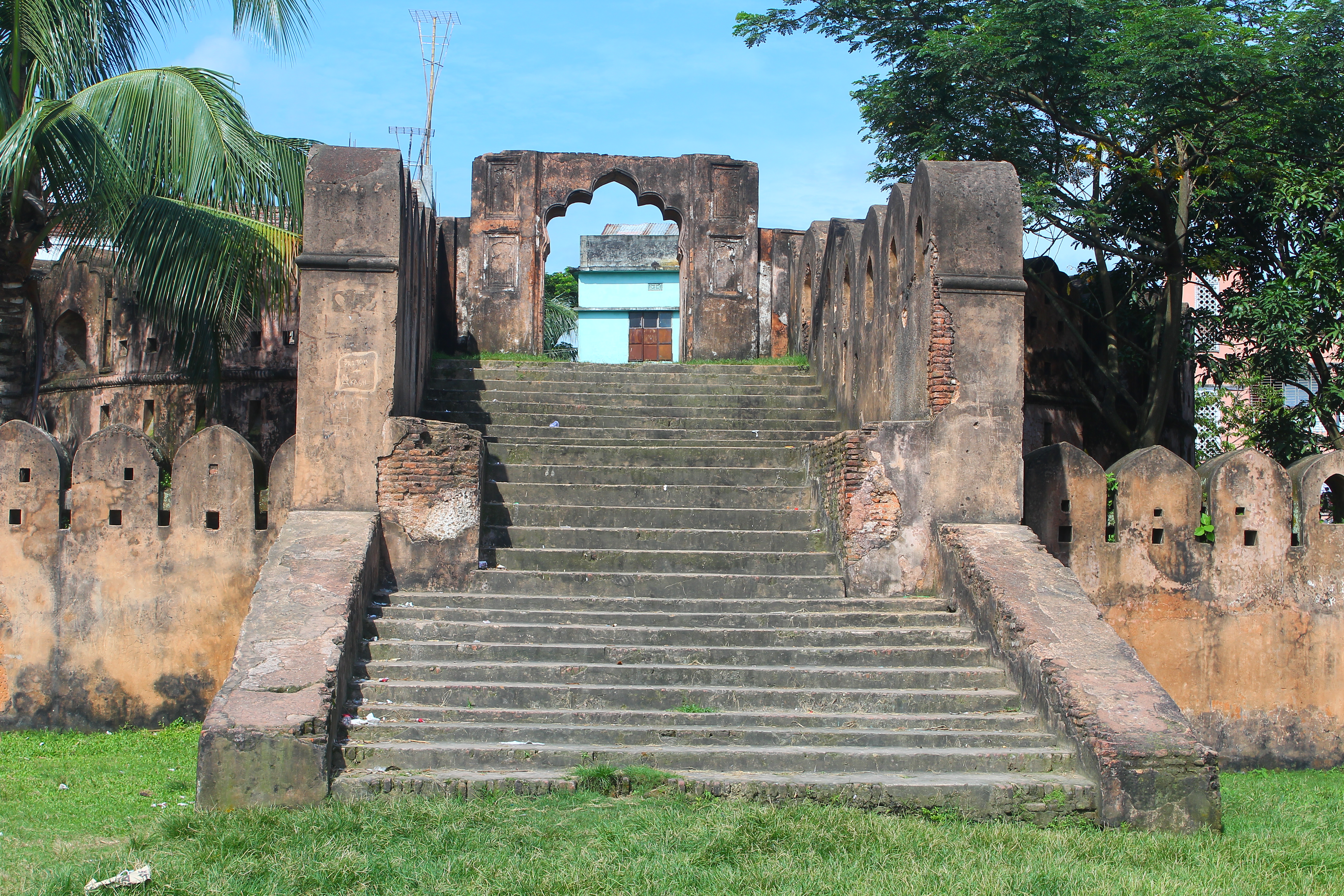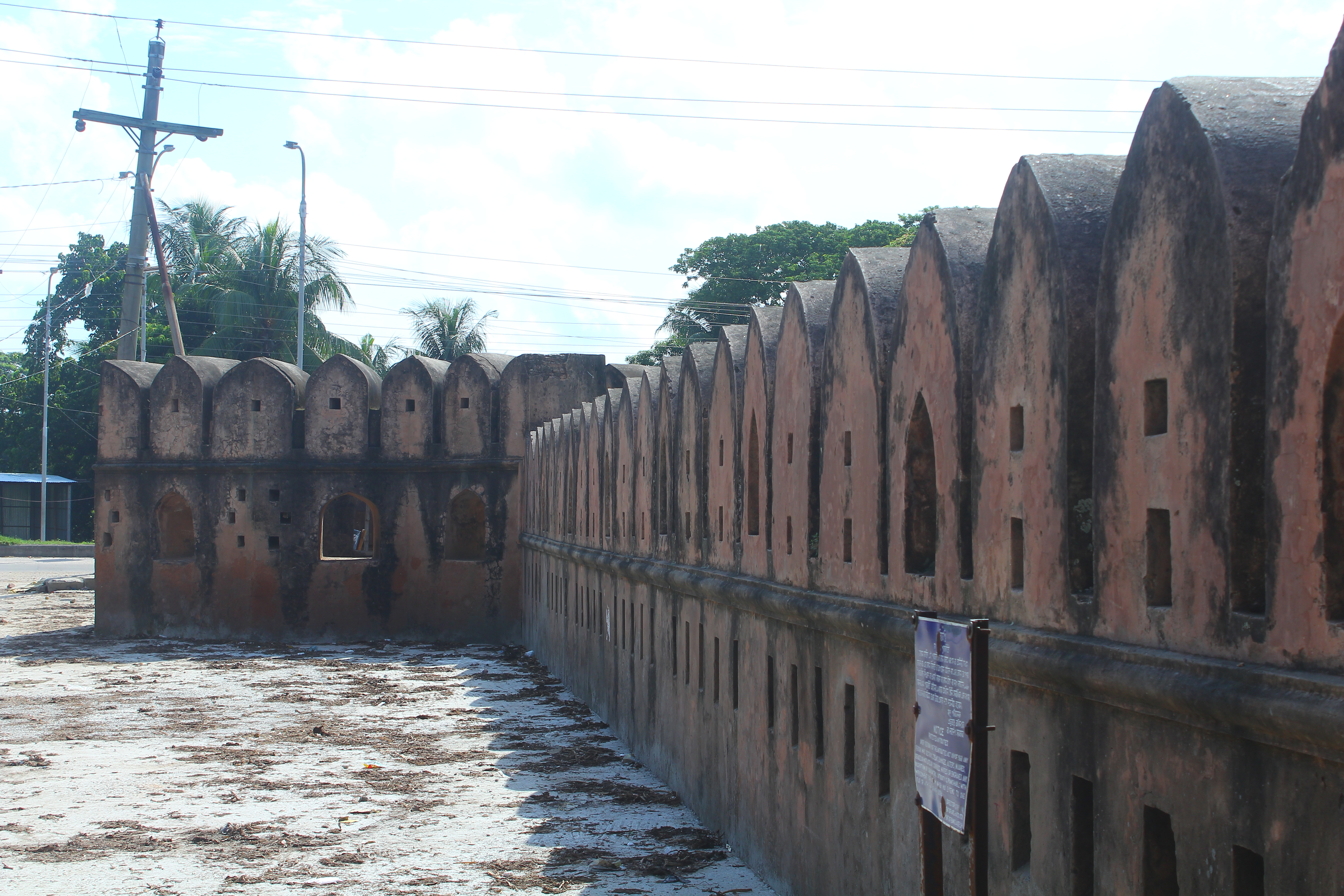Sonakanda Fort on:
[Wikipedia]
[Google]
[Amazon]
 Sonakanda Fort is a river fort situated in
Sonakanda Fort is a river fort situated in
 The fort combines thick walls, a massive artillery platform and a gateway to the north.
The fort has two main parts. One is a fortified defensive wall of gigantic dimensions. The defensive walls are 3.05 metres in height and thicker at the bottom. Several wide and narrow loopholes allowed guns and light cannons to fire shells at the pirates. The other one is a raised outwork on the western face to defend the fort from the attack of the pirates.
The most significant structure of the fort is the massive artillery platform. One of the spherical artillery platforms has a stairway, which leads up to the artillery platform. Cannons with bigger calibre were placed on there, aiming at the aggressors coming up the
The fort combines thick walls, a massive artillery platform and a gateway to the north.
The fort has two main parts. One is a fortified defensive wall of gigantic dimensions. The defensive walls are 3.05 metres in height and thicker at the bottom. Several wide and narrow loopholes allowed guns and light cannons to fire shells at the pirates. The other one is a raised outwork on the western face to defend the fort from the attack of the pirates.
The most significant structure of the fort is the massive artillery platform. One of the spherical artillery platforms has a stairway, which leads up to the artillery platform. Cannons with bigger calibre were placed on there, aiming at the aggressors coming up the
 There are a number of
There are a number of
The World Monuments Fund's 2008 Watch List page for Sonakanda Fort
Palaces in Bangladesh Forts in Bangladesh Narayanganj Mughal fortifications
 Sonakanda Fort is a river fort situated in
Sonakanda Fort is a river fort situated in Narayanganj
Narayanganj () is a city in central Bangladesh in the Greater Dhaka area. It is in the Narayanganj District, about southeast of the capital city of Dhaka. With a population of almost 1 million, it is the 6th largest city in Bangladesh. It is als ...
, Bangladesh, on the eastern bank of Shitalakshya River
Shitalakshya River ( pronounced: ''Shitalokkha Nodi'') (also known as Lakshymā River) is a distributary of the Brahmaputra River, Brahmaputra. A portion of its upper course is known as Banar River or Banor River. In the Shitalakshya's initial sta ...
. Though the time of its establishment could not be ascertained, historians believe that the river fort was built by Mir Jumla II, a Subahdar
Subahdar, also known as Nazim, was one of the designations of a governor of a Subah (province) during the Khalji dynasty of Bengal, Mamluk dynasty, Khalji dynasty, Tughlaq dynasty, and the Mughal era who was alternately designated as Sahib- ...
of Bengal
Bengal ( ) is a Historical geography, historical geographical, ethnolinguistic and cultural term referring to a region in the Eastern South Asia, eastern part of the Indian subcontinent at the apex of the Bay of Bengal. The region of Benga ...
under the Mughal Empire
The Mughal Empire was an Early modern period, early modern empire in South Asia. At its peak, the empire stretched from the outer fringes of the Indus River Basin in the west, northern Afghanistan in the northwest, and Kashmir in the north, to ...
, to defend Dhaka
Dhaka ( or ; , ), List of renamed places in Bangladesh, formerly known as Dacca, is the capital city, capital and list of cities and towns in Bangladesh, largest city of Bangladesh. It is one of the list of largest cities, largest and list o ...
and Narayanganj
Narayanganj () is a city in central Bangladesh in the Greater Dhaka area. It is in the Narayanganj District, about southeast of the capital city of Dhaka. With a population of almost 1 million, it is the 6th largest city in Bangladesh. It is als ...
from pirates.
History
Bengal
Bengal ( ) is a Historical geography, historical geographical, ethnolinguistic and cultural term referring to a region in the Eastern South Asia, eastern part of the Indian subcontinent at the apex of the Bay of Bengal. The region of Benga ...
went under the effective control of the Mughal Empire
The Mughal Empire was an Early modern period, early modern empire in South Asia. At its peak, the empire stretched from the outer fringes of the Indus River Basin in the west, northern Afghanistan in the northwest, and Kashmir in the north, to ...
in 1574 AD after the defeat of Daud Khan Karrani by the Mughal General Munim Khan. Mughals exercised a progressive rule in Bengal and were determined to protect their subjects from external forces.
Mir Jumla II was appointed as the Subahdar or governor of the then Bengal province in 1660 AD. He was aware of the pirates who ran a campaign of terror in the important cities of Bengal. In a quest to protect the capital Dhaka
Dhaka ( or ; , ), List of renamed places in Bangladesh, formerly known as Dacca, is the capital city, capital and list of cities and towns in Bangladesh, largest city of Bangladesh. It is one of the list of largest cities, largest and list o ...
from the pirates, Mir Jumla II decided to build three river forts around Dhaka, including Sonakanda Fort.
Though archaeologists cannot trace any evidence on its date of establishment, according to historians the construction of the fort started between 1660 and 1663 AD.
Structure
 The fort combines thick walls, a massive artillery platform and a gateway to the north.
The fort has two main parts. One is a fortified defensive wall of gigantic dimensions. The defensive walls are 3.05 metres in height and thicker at the bottom. Several wide and narrow loopholes allowed guns and light cannons to fire shells at the pirates. The other one is a raised outwork on the western face to defend the fort from the attack of the pirates.
The most significant structure of the fort is the massive artillery platform. One of the spherical artillery platforms has a stairway, which leads up to the artillery platform. Cannons with bigger calibre were placed on there, aiming at the aggressors coming up the
The fort combines thick walls, a massive artillery platform and a gateway to the north.
The fort has two main parts. One is a fortified defensive wall of gigantic dimensions. The defensive walls are 3.05 metres in height and thicker at the bottom. Several wide and narrow loopholes allowed guns and light cannons to fire shells at the pirates. The other one is a raised outwork on the western face to defend the fort from the attack of the pirates.
The most significant structure of the fort is the massive artillery platform. One of the spherical artillery platforms has a stairway, which leads up to the artillery platform. Cannons with bigger calibre were placed on there, aiming at the aggressors coming up the Shitalakshya River
Shitalakshya River ( pronounced: ''Shitalokkha Nodi'') (also known as Lakshymā River) is a distributary of the Brahmaputra River, Brahmaputra. A portion of its upper course is known as Banar River or Banor River. In the Shitalakshya's initial sta ...
. This is a unique feature of the river forts built by Mughal Empire.
The platform is surrounded by two circular structures of which the diameter of the inner one is 15.70 metres and the diameter of the outer one is 19.35 metres. The structure is 6.09 metres in height and surrounded by walls.
The fort is quadrangular in plan, measuring 86.56 by 57.0 metres. There are octagonal bastions on the four corners of the fort. The corner bastions on both sides of the western wing are wider than those of the eastern wing, which are 4.26 metres, while the two on the western wing are 6.85 metres in width.
The only gate of the fort is on the north. The arched entrance is placed within a rectangular frame. The gateway is higher than the average height of the walls of fort and decorated with several groomed panels.
Myths
 There are a number of
There are a number of anachronistic
An anachronism (from the Greek , 'against' and , 'time') is a chronological inconsistency in some arrangement, especially a juxtaposition of people, events, objects, language terms and customs from different time periods. The most common typ ...
myths related to the river fort that include tragedy and mystery.
* Princess Swarnamoyee, daughter of Kedar Roy, ruler of Bikrampur, went to the Shitalakshya River to perform sacred bath. Her barge was attacked by pirates, and the princess was kidnapped. She was later saved by Isa Khan Niazi
Isa Khan Niazi () was an Pashtuns, Afghan noble from the courts of Sher Shah Suri and his son Islam Shah Suri, of the Sur Empire, who fought the Mughal Empire.
Biography
Isa Khan Niazi was born in 1453 in present day Isakhel of Mianwali D ...
, the ruler of Sonargaon
Sonargaon (; ; Literary translation, lit. ''Golden Hamlet (place), Hamlet'') is a historic city in central Bangladesh. It corresponds to the Sonargaon Upazila of Narayanganj District in Dhaka Division.
Sonargaon is one of the old capitals of ...
. Isa Khan brought her to the Sonakanda Fort and asked her father to take her back. Kedar Roy, however, refused to take her back as she had lost her caste by spending a night in a tent owned by a Muslim ruler. Swarnamoyee, shocked by the incident, cried for several days in her tent at Sonakanda Fort. It is said that name of the fort is derived from this incident-- Sona or gold being a reference to the name Swarnamoyee and ''kanda'' being the Bengali word for crying.
* Another version of the story says that Isa Khan
Isa Khan (Middle Bengali: , 17 April 153629 August 1599) was one of 16th-century Baro-Bhuyan chieftains of Bengal. During his reign, he successfully unified the chieftains of Bengal and resisted the Mughal invasion of Bengal. It was only afte ...
forcefully married Sona Bibi, a widowed daughter of Kedar Roy. She was brought to this fort and put under confinement by Isa Khan's soldiers. She cried following the incident and the name of the fort derived from that.
* Some people believe that there were some hidden tunnels in the fort that linked it with Sonargaon and Lalbagh Fort
The Lalbagh Fort () is a historic fort situated in the old city of Dhaka, Bangladesh. Its name is derived from its neighbourhood Lalbagh, which means Red Garden. The term Lalbagh refers to reddish and pinkish hues in the Mughal architecture. Th ...
.
See also
*Hajiganj Fort
Hajiganj Fort, also known as Khizirpur fort, situated at Hajiganj locality of Narayanganj, Bangladesh, on the western bank of Shitalakshya.
History
The exact date of Hajiganj fort is uncertain but it may have been built soon after Subahdar Isl ...
* Idrakpur Fort
Idrakpur Fort is a river fort situated in Munshiganj, Bangladesh. The fort was built approximately in 1660 A.D. According to a number of historians, the river fort was built by Mir Jumla II, a Subahdar of Bengal under the Mughal Empire, to es ...
* List of archaeological sites in Bangladesh
This article lists the archeological sites in Bangladesh. Below is a division-wise overview of some notable archaeological sites.
Dhaka Division Dhaka
* Ahsan Manzil
* Armenian Church, Dhaka
* Bara Katra
* Bhajahari Lodge
* Buckland Bund
* ...
References
{{reflistExternal links
The World Monuments Fund's 2008 Watch List page for Sonakanda Fort
Palaces in Bangladesh Forts in Bangladesh Narayanganj Mughal fortifications